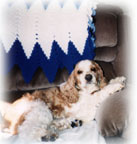Arthritis and
the Cocker Spaniel
Disclaimer: the information set forth below is based on personal research and experience as a pet owner. I am NOT a vet, and there is no substitute for good veterinary care. Use this information as a starting point for your own research, and CONSULT YOUR DOG'S VETERINARIAN.

by Dr. Race Foster, DVM, Drs. Foster & Smith, Inc. edited for CockerCondo by KS Alexander
Many pets develop some form of arthritis during their lives. It can be mild, even unnoticeable to you, the owner, or it can be debilitating, severely affecting the pet's quality of life or even causing complete lameness. The majority of cases fall somewhere in between.
While some pets may develop arthritis in the first half of their lives, signs usually don't appear until the latter half of life. The most common signs of arthritis include stiffness, limping, or favoring a limb -- particularly after sleep or resting, inability to rise, reluctance to jump or even climb stairs, and noticeable pain.
Causes of Arthritis
While some arthritis is caused by an injury to a joint (traumatic arthritis), most often it is a degenerative form of arthritis, called osteoarthritis. Degenerative arthritis is usually an inherited trait such as hip dysplasia, but can be caused or at least hastened by nutritional deficiencies, infection, and excessive or abnormal wear and tear on joints.
Defined as an inflammation of the joints, osteoarthritis involves the deterioration of the smooth cartilage that covers and protects the end of a bone. A lack of sufficient cartilage between joints causes abnormal new bone growth at the joint to fill in the "gap" once occupied by the cartilage. This bone-against-bone abnormality results in the pain and inflammation associated with arthritis.
What You Can Do to Help
Since there is no cure for arthritis, treatment is generally aimed at relieving the pain and providing comfort. There are also actions you can take toward the goal of slowing down the degenerative process.
- Provide buffered canine aspirin as needed. Aspirin is an extremely effective way to relieve pain in dogs and every home with an arthritic dog should have it on hand. (Aspirin should not be used in cats.) Canine Aspirin works on both the affected area and the pain center in the brain and is time-released for long-lasting effect. Pain-relieving steroids (such as rymidal) are available for severely arthritic dogs. Consult your veterinarian for more information.
- Exercise your pet daily. Walks, games of fetch that do not involve jumping or sharp turns, and especially swimming help maintain muscle mass which will reduce stress on joints. Don't overdo as too much could aggravate the condition.
- Lower your pet's weight. Extra weight adds considerable stress on joints. If your Cocker Spaniel (Cocker Pig?) is overweight, start him on a weight reduction program immediately. Reduce the amount of food given and cut out table scraps (other than raw fruits and vegetables). If you provide treats, choose treats that are low in fat and sugar. Carrot stix are wonderful!
- Provide a firm, orthopedic foam bed. Beds with dome-shaped orthopedic foam distribute weight evenly and reduce pressure on joints. They are also much easier to get out of. Place the bed in a warm spot away from drafts. Next to a heat register is best.
- Slip on a Sweater. Conditions tend to worsen in cold, damp weather. A pet sweater will help keep joints warmer. You may want to consider keeping the temperature in your home a little warmer, too.
- Give your CockerBaby a massage. A soothing massage of the affected area helps relieve stiffness and soreness. Remember, your dog is in pain so start slow and build trust. Start by petting the area and work up to gently kneading the muscles around the joint with your fingertips using a small, circular motion. Gradually work your way out to the surrounding muscles. Moist heat is also beneficial. A water bottle or soaked towel works best.
- Elevate your pet's food and water bowls. Elevated feeders make eating and drinking more comfortable for arthritic pets, particularly if there is stiffness in the neck or back.
- Start your pet on Joint Care, Cosequin or some other Glucosamine-Chondroitin supplement. We at CockerCondo SWEAR by these supplements. They gave Checkmate a second wind on life! Developed specifically to help slow down the degenerative process of arthritis and hip dysplasia, this nutritional supplement combines three ingredients which are thought to work directly on the cartilage of joints -- Glucosamine HCl, Chondroitin Sulfate, and Vitamin C.
- Finally, there are surgical options which may help your pet, but these are typically reserved for animals with more incapacitating symptoms. Consult with your veterinarian if you have questions about this course of action.
It is never easy to see a beloved pet and friend in pain. And while there isn't yet a cure to this unfortunate disease, there is much you can do to control the pain, make your pet comfortable, and perhaps slow down the progression of the symptoms.
another Internet resource is:
The Pet Arthritis Resource Center (http://www.arthritis-glucosamine.net/pet-arthritis/) A very informative site about arthritis in pets. Over 100 articles on treating arthritis and hip dysplasia in pets, the science backing glucosamine, a review of treatments, a pet arthritis newsletter, and much more.
This page last updated 4/9/06  Get your own FREE Website at
Get your own FREE Website at 







